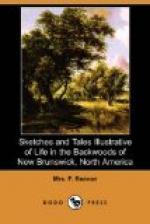We had been living for some time at a place called Long Creek, on the margin of a broad and rapid stream, which might well have borne the more dignified appellation of river—the land on its borders was the flat, rich “intervale,” so highly prized, formed by alluvial deposits. There are, I believe, two descriptions of this intervale,—one covered with low small bushes, and, therefore, more easily cleared—the other with a gigantic growth of the butternut, the oak, and the elm. This where we lived was of the latter description. A few of the stately monarchs of the forest yet stood upon the emerald plains, spreading their magnificent branches to the sunlight, and telling of the kindly soil that nourished them. Along the fences wild hops festooned themselves in graceful wreaths of wild luxuriance. A few clumps of cranberry bushes had also been permitted to remain, notwithstanding the American’s antipathy to trees or bushes is such, that his axe, which he hardly ever stirs without, is continually flying about him; but this berry, one amongst the many indigenous to the country, is a useful addition to the winter store—they grow abundantly, and, after the first frost which ripens them they have a brilliant appearance, hanging like clustering rubies, reminding one of the gem-clad boughs of Aladdin. When gathered, they are hung up in bunches, when they become frozen, keeping good till the spring. They are used for tarts and jellies, the frost neither altering their colour nor flavour. Those places are overflown in the spring;




